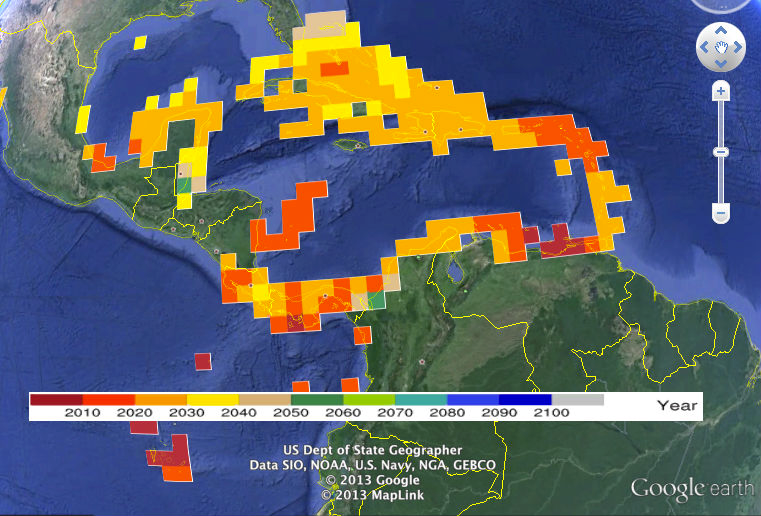A new Google Earth tool contains the most recent projections of coral bleaching and ocean acidification for all coral reef areas. The projections are based on climate models from the IPCC’s Fifth Assessment Report. Using this tool, managers can go to areas of interest and view:
- The years by which two thermal stress levels known to cause bleaching are projected to occur twice per decade and annually;
- Projected declines in aragonite saturation state as well as corresponding declines in calcification.
The use of the tool and images obtained from it will help coral reef managers to communicate about the threats posed to reefs by climate change with their colleagues, stakeholders and with policymakers.
The associated paper summarizes the results of the projections and highlights that under the fossil-fuel aggressive emissions scenario, there are no refugia from the onset of annual severe bleaching or the effects of ocean acidification. Under this scenario, by 2053, 90% of all coral reef areas will experience annual severe bleaching. There are opposite latitudinal gradients in these threats to reefs, meaning that areas projected to experience annual bleaching later are exposed to the effects of acidification for longer.
The Reef Resilience Program spoke with one of the authors of the report, Dr. Ruben van Hooidonk, about the relevance of this tool for coral reef managers.
Is there any good news coming from your findings?
Overall, the news is rather pessimistic, but the projections do show that some reefs will experience bleaching conditions annually 20 years or more later than others will. Many of these locations are of both local and global significance, such as the southern part of the Great Barrier Reef.
How do you see a coral reef manager using this tool?
The tool we have built allows access to projections that have coarse resolution (1 degree by 1 degree) and for long periods of time (decades). Therefore, the results do not inform the targeting of management interventions like reducing pressures from fishing and scuba, though they do increase the impetus for such actions. The primary purposes for which the projections were developed and made available are long term planning and outreach/awareness-raising.
What next steps do you think a coral reef manager should take after reading this article to address the impacts of ocean acidification and coral bleaching at their site?
Our article and the tool we have made available highlight the plight of coral reefs. Although a reef manager cannot easily address the global issues of increasing temperatures and acidification, managers can reduce local stressors that compound those associated with climate change and acidification. Perhaps more than any article before it, our work shows the urgency and necessity of local actions that support the natural resilience of reef systems.



